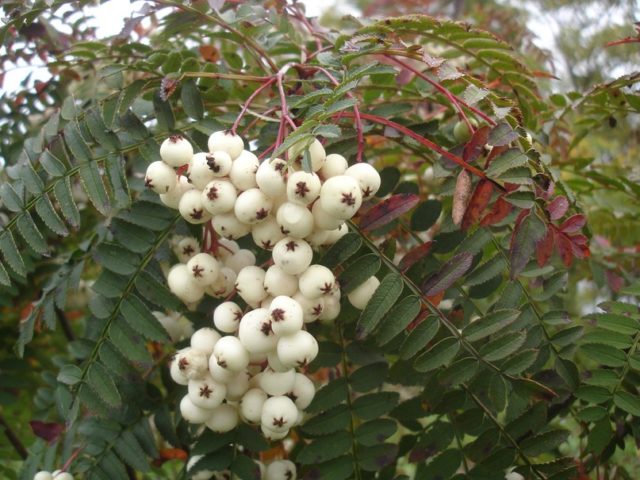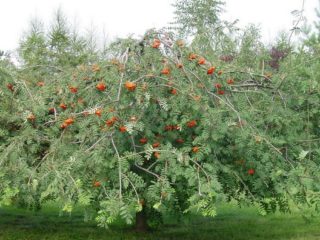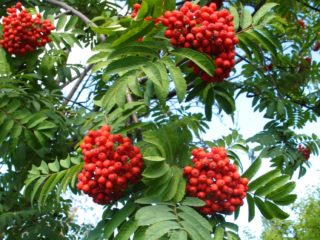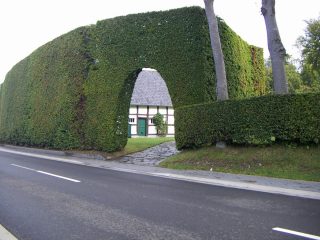Content
Rowan Kene is a miniature tree used in landscape design. In nature, mountain ash with white fruits is found in the central and western regions of China, sometimes it can be seen in Russia, in the Far East.
Description of Kene rowan
Mountain ash of this variety in nature grows up to 3-4 m in height, and cultivated seedlings do not exceed 2 m. The crown of the tree is spreading, with openwork foliage. The main difference between Kene mountain ash and ordinary one is the color of ripe fruits.
In common mountain ash, the bunches have an orange-red hue, and the Kene berries (pictured) acquire a creamy white color.
The shape of the brushes and berries is the same as the common mountain ash. Perianths on a white background of berries look like black dots, so the berries resemble beads. The berries are not poisonous, but they have a bitter-sour taste; birds willingly feast on them.
The approximate flowering time is May, June. The flowers are white, collected in corymbose inflorescences. The diameter of the inflorescences is about 10 cm in diameter.
The bark of the trunk is brownish-red. The length of the foliage reaches 25 cm, which is much longer than the length of the leaves of the common mountain ash, the structure of the leaf blades is similar. The color of the foliage changes with the seasons. In summer, the crown is covered with emerald green leaves, and in autumn they turn crimson.
Pros and cons of the variety
Considering the positive qualities of Kene rowan, it should be noted:
- decorative appearance;
- compactness and low height;
- undemanding to the composition of the soil.
The variety tolerates planting in gas-polluted industrial regions, therefore it is suitable for urban landscaping.
Of the minuses of the variety, the following are distinguished:
- the possibility of freezing of flower buds, which leads to the absence of flowers and fruits;
- seedlings of this variety are photophilous, therefore planting with tall trees is not recommended.
Planting and caring for Kene rowan
In order for the Kene mountain ash to please with its decorative qualities, it is necessary not only to acquire a viable seedling, but also to choose and prepare the planting site correctly, as well as take care of the culture.
Landing site preparation
Rowan Kena is not recommended to be planted in damp lowlands. Its root system can suffer from the close occurrence of groundwater. There should be no tall trees 5 m in diameter from the seedling. In the shade of other crops, rowan will pause formation and may not bloom.
A good place to plant is in the southern or western areas, you can choose the upper part of the slopes or flat terrain. When planting mountain ash, the upper third of the slopes has advantages over other territories. There is a lot of sun, and the cold air sinks down, so the trees do not freeze. The slopes protect the seedlings from the north wind. On sloping areas, snow collects, which does not melt for a long time in spring, protecting the trees from recurrent frosts.
Landing rules
Best of all, Kene's mountain ash feels on fertile, well-drained soils.
The average size of the hole: 50x50 cm.If a drainage layer is required, then the depth of the hole is increased to 70-80 cm.The following components must be added to the planting hole:
- sod land - 3 parts;
- humus - 2 hours;
- sand - 2 tsp
If the purchased seedling has an open root system, it is transplanted in the fall or early spring. Autumn planting in September-October is preferable to spring planting.If the seedling has an earthen lump, you can transplant it at any time of the year (except for winter).
Rowan Kene can be planted singly or in large quantities. In the second case, a distance of at least 4 m is left between the landing holes.
Watering and feeding
The frequency of watering a mature tree depends on the conditions in the region. In dry times, the number of irrigations is increased (1-2 times a week), if it rains, additional moistening of the earth is not required.
To keep the root zone moist, the seedlings are watered regularly, and the ground must be loosened. Loosening and mulching helps to get rid of weeds. Peat, humus, compost or sawdust are used as mulch. The layer of mulch should be at least 5 cm. 1-2 times a year, the mulch is dug up with the soil, and a new layer is poured on top. This procedure is especially relevant before wintering.
In the third year after planting, the seedlings need feeding. The most successful fertilization option:
- before flowering in spring, nitrogen-phosphorus-potassium compounds are used (20-25-15 g, respectively) per 1 m² of the area of the trunk circle;
- in the summer, the amount of fertilizer is reduced. A nitrogen-phosphorus-potassium composition is introduced in the following ratio: 10-15-10 g;
- in the fall, nitrogen fertilizers are excluded from the composition of fertilizers, since they stimulate the growth of branches and prevent the tree from preparing for winter. Phosphate and potash fertilizers are taken in equal parts - 10 g per 1 m² of the planting area.
Pruning
In spring, rowan bushes start growing very quickly, so it is important not to be late with pruning. The longest shoots are shortened, pruning is done on the outer bud. Fruiting shoots are shortened a little, and the crown must be thinned out.
If rowan grows poorly, rejuvenating pruning is performed for 2-3-year-old wood. This stimulates the formation of new shoots.
Preparing for winter
It is advisable to mulch young seedlings of a white-fruited variety for the winter. A layer of mulch will protect the root system from freezing. In central Russia, the adult Kene mountain ash is able to hibernate without shelter, it is not afraid of frosts, but wet and windy weather in winter. If the flower buds of a culture freeze, it quickly recovers, but this season it does not bloom and does not bear fruit.
Pollination
It is advisable to plant white-fruited varieties at a distance of 4-5 m from each other, in addition, to obtain a high yield, gardeners recommend planting several varieties at once. Single trees are self-fertile, but their yield is less than in mass plantings of different varieties.
Harvesting
The harvest hangs on the branches of mountain ash even after frost. Birds eat berries, but the harvest can be harvested by humans. So that the berries do not taste bitter, they harvest after the first frost. If the berries are harvested before frost, they must be sorted out, removing the leaves and stalks, then left in the air to wither and dry. Fresh fruit can be stored in the freezer.
Due to the strong bitterness, the fruits of the Kene variety are not recommended for food.
Diseases and pests
The main pests of Kene rowan are:
- aphid;
- mountain ash moth;
- spider mites.
Of the diseases, rust is most often found, which can destroy a seedling if a person does not take any action to combat the disease.
To combat insect pests, insecticides are used; for the prevention and prevention of diseases, they are sprayed with copper-containing agents.
Reproduction
Reproduction of rowan of this variety can be carried out in several ways:
- seeds. Planting material must be stratified, or sown before winter;
- cuttings. The method is considered effective, because.the percentage of rooting even without the use of chemicals is about 60;
- vaccination can be used, Rowan is suitable as a stock.
Conclusion
Rowan Kene is a white-fruited variety, distinguished by its low height and beautiful appearance. Mature trees of this variety are unpretentious, do not need special care. White-fruited mountain ash is used for landscaping city parks and squares, it can be planted in a private courtyard.
Reviews about Kene rowan
I decided to make a hedge at the dacha. I chose Kene rowan seedlings for landscaping. I really liked her look. White berries with black dots-tails, resembling beads, seemed especially unusual. Planted, alternating with rowan bushes.
I watered the seedlings, mulched the tree circle, I can’t note any more difficulties with leaving. The variety is unusual, therefore it attracts attention. The hedge is very beautiful. The combination of white and orange fruits is eye-catching.
I work as a landscape designer. People love unusual ideas and new varieties. She began to offer Kene mountain ash, customers like its appearance, small size and undemanding to growing conditions.
Rowan Kene can be planted against the background of coniferous seedlings (pines, firs, fir). The shrub is also combined with deciduous species (linden, black poplar, white willow).
If the plot is small, the Kene rowan tree can be planted in a single copy.










